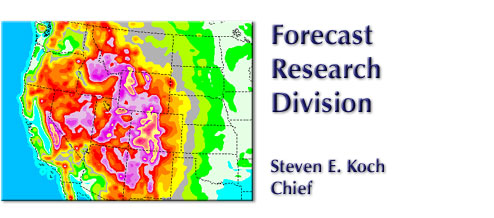|
|


Introduction
Forecast Research
|
|

Objectives The Forecast Research Division is home to most of the research in FSL on short-range forecasting and small-scale weather phenomena. The division emphasizes the assimilation of diverse meteorological observations for analyzing current atmospheric conditions and the subsequent generation of short-range numerical forecasts. Produced in real time at frequent intervals on national and local scales, these analyses and forecasts are valuable to commercial aviation, local forecasters, and emergency preparedness agencies. They also have supported or will support several large meteorological field experiments. Concurrent with the assimilation and modeling research is the study of small-scale phenomena such as clear-air turbulence and thunderstorms. The Forecast Research Division comprises three branches:
Local Analysis and Prediction Branch Meteorological Applications Branch The Regional Analysis and Prediction Branch develops and supports the following research programs:
Data Assimilation – Improved techniques for estimating meteorological parameters on a regular grid, combining information from a four-dimensional set of observations with a forecast model. The Branch conducts research on the use of new data sources. Numerical Prediction – Design, testing, and implementation of improvements to the MAPS/RUC numerical prediction model. A strong effort is made to improve representation of processes near the surface and in clouds, which exert a strong control on mesoscale forecasts. Analysis and Model Verification – Statistical and subjective evaluations are made of MAPS/RUC analysis and forecast products for standard atmospheric variables, aviation-impact variables, and precipitation. Data Sensitivity Studies – Using MAPS, studies are conducted to determine the effects of different types of observations on short-range numerical forecasts. Well-Posed Model – Development of an accurate multiscale, limited-area forecasting model that is not sensitive to errors in the initial, boundary, and forcing data. The Local Analysis and Prediction Branch supports four major tasks: Local Analysis and Prediction System (LAPS) – Incorporation of new datasets into numerical models for the production of very detailed analyses of local weather conditions and short-range forecasts. The model is updated with new observations at least hourly. LAPS plays a major role in FSL's Aviation Program, particularly in diagnosing and predicting aviation terminal weather. LAPS Observation Simulation System – A system designed to evaluate new observation technology or siting of existing observational systems. This system has been employed to assess the potential of new satellite systems for the Department of Defense (DOD) and instrument placement around eastern and western space centers of the U.S. Air Force and the National Aeronautics and Space Administration (NASA). Satellite Products – Development and evaluation of workstation products derived from atmospheric soundings aboard the Geostationary Operational Environmental Satellite (GOES). WFO Advanced Support – Full support of an operational version of LAPS on the WFO- Advanced workstation, including both analysis and prediction. The WFO-Advanced forecaster workstation is used to demonstrate Advanced Weather Interactive Processing System (AWIPS) functions in support of future Weather Forecast Office (WFO) operations. The Meteorological Applications Branch conducts research to increase the understanding of synoptic-scale and mesoscale weather systems. Scientists develop and improve conceptual and diagnostic models of the atmosphere using data from conventional instruments and new state-of-the-art sensors. Many research results are applicable to operational weather forecasting. Specific research areas under investigation are:
|
|
